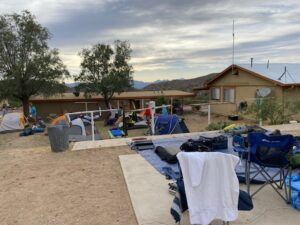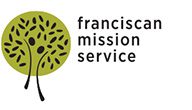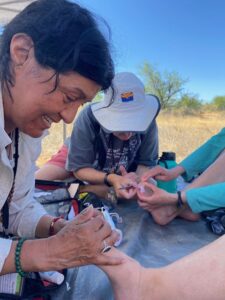Memorials on the Migrant Trail

Editor’s note: Each year, an organization called The Migrant Trail in Arizona leads a solidarity walk across the US-Mexico border and through a well-traversed valley, giving walkers a chance to experience the region and bear witness to the place where thousands of people in migration have lost their lives. This year, missioners Mari and Julia were able to experience the trail, which Mari details in this story. *Initials are provided to respect each individual’s privacy.
For 20 years, people have been participating in a 7-Day, 75-Mile Migrant Trail from Sasabe, Mexico to Tucson, Arizona in solidarity with migrants and remembering those who lost their lives each year.Last year, and since 2020, it was done by online presentations because of COVID precautions, so I was anxious to participate in-person this year.
We, a group of roughly 30, gathered in a Tucson church to initiate our intentional journey together at a Sunday night dinner and orientation, then sleep over. The next morning, we entered the church where, under spring-colored Easter streamers, we approached the table full of simple white crosses with names and ages written in black – it is time to become a pair. Who will I carry on my back, cradle in my arm, hold up to remember, here in spirit?
As you read further, I invite you to listen to the song “Mothers of the Disappeared” by U2; the lyrics act as headers for my “real time” entries and the melody hauntingly captures the solidarity experience of the walk.
Mothers of the Disappeared …
© U2, The Joshua Tree, 1987
Mothers of the Disappeared — U2 | Last.fm
At the altar table that first morning, I select “Desconocido/a” … a name, it is not. That is a status. This soul’s remains are not just unidentifiable; it is also unclear whether I carry the cross of a female or a male. Day turned to pitch-black night again and again and again before “Unknown” was found. Think about that.
Midnight, our sons and daughters …
Other crosses have an individual’s name and age on them. Most are for men like the young adult hombres I’ve met at the Migrant Resource Center. One is the name of a girl from India traveling in a group with her mother; they ran out of water. She was six. Six.
Each walker finds a seat in the 13-vehicle caravan as we drive 90 minutes southwest and take in the route we will be walking. I hear of S & S’s dedication to preparing immigrants for the citizenship test and registering them to vote. Something to think about as I discern what’s next for me after my time in mission. As we arrive, we form one line for Mexico’s Customs agents, and as we cross the border, we are just steps from Casa de la Esperanza, a center for deported migrants and residents of the Sasabe, Sonora, Mexico community.

Julia and three other Migrant Traill walkers volunteer to carry a coffin representing the women who have died near the trail from Casa de la Esperanza to the Border.
Cut down and taken from us …
After lunch there, twelve in our group volunteer to carry three caskets representing the men, women, and children who have lost their lives this past year; we form a large prayer circle around them, alongside the border entry point for cars and pedestrians. Here, the Wall stands atop the rolling landscape. M, a tall, engaging Native American woman in our group, initiates our journey north with a smudging ceremony, the burning of certain herbs which she moves in front of each of us, to purify and bless us from head to toe. She then unfurls the long spindle of yarn from one side of the circle to the opposite, with 160 rose-like ties made in it, each representing a migrant life lost here this year. She will roll the long yarn of prayer ties back up; they are ready to be solemnly carried in the arms of the first person in line for each leg of the journey.
Hear their heartbeat …
After we make our way walking the edge of the asphalt road, we take a right into Buenos Aires National Wildlife Refuge near the Tohono O’odham Nation Reservation. The sound of my feet is nearly absorbed by the gravel and rust-brown dirt on the trail. We walk in double file on its dirt roads, single file on the paved routes with traffic. This will be our formation; we begin our days with a silent leg; talk on the next and rotate accordingly. We have a group rhythm. We chit-chat. My cross sticks out of my light drawstring backpack. I wonder if the migrants ever feel relaxed enough to chit-chat. Ba-boom, Ba-boom…
We hear their heartbeat …
Ba-boom, Ba-boom. Tuesday. 13.7 miles.
In the wind, we hear their laughter…
On “Windsday,” after 10.8 miles and 7 stops to eat and fill our water bottles with the provisions in our caravan, we are done for the day. We rest under cover at our camp, reading and talking with each other before another delicious, super-hearty vegetarian dinner is prepared and delivered to us by a supporting nonprofit.
As the winds in the West are prone to do, hot gusts begin to bluster and swirl, making us reach up from our folding chairs to grab the white tents’ bars and keep them staked. Cots are blowing over. I find the winds humbling and unsettling; we carry so many possessions to make this journey comfortable. Brother Wind makes that wildly evident.
In the rain, we see their tears …
Tonight, it’s a muted cacophony of coyotes’ screeching, men snoring, and my clamoring thoughts of how cold it is, but the Milky Way blankets me in her longitude. I doze off gazing upward and awake in my now dew-covered bag.

Tent City at our camp where we could hoist our cots and bags up on the tarp for early morning loading.
Hear their heartbeat …
We rally early, up at 4 or 5 a.m. usually… it’s a rush to get tents and sleeping bags, duffles and chairs packed and on the tarp in the right section for the logistics team to load in 30 minutes. Julia, my fellow missioner, leaves our site early, jazzed by the morning puzzle of making it all fit just-so in the small trailer. M has the coffee brewed. E gave us a quiet start to the first morning in the refuge, but a Native American chant, heavy on the drums, has become our wake-up alarm from his lead vehicle. Fitting, very fitting. Ba-boom. Ba-boom.
We hear their heartbeat …
In just a few steps on the path north, we are in a quiet cadence. On this Thursday morning, we are in the dark, lighting our way with headlamps and flashlights, attentive to branches and rocks and road ruts as we start our longest day of 15.9 miles at 4 a.m. We will be leaving the Wildlife Refuge but not before witnessing a gorgeous sunrise on Baboquivari Mountain, a sacred place of the Tohono O’odham people. Ba-boom, Ba-boom.
Night hangs like a prisoner…
I am relieved to not hear unexplained rustling in the grasses; the wildlife in the Sonoran region are hardcore, many hiss. We pair up and take turns on a two-hour “watch” throughout the night to make sure the group remains safe from any threat, but it’s quiet – well, there was the guy who drove up to our roadside lunch one day and asked what we were doing. There was something mixed-in with his so-called curiosity; my arm hair stood on end. L invited him to have lunch; he declined and drove off. But J and I know the plan, we formulate a few what-ifs. We chat a bit and scan the trail left and right, while she reads a book and I scroll with my remaining charge. Some of this is what migrants may experience — with a lot more anxiety. We are seated side by side, bundled in our sleeping bags, and my legs are restless. Finally, our shift concludes, and I head toward M, she to rouse O.
Stretched over black and blue …
Sister Moon has been fulsome, yet we still need to carry flashlights to light our path through camp. I make a trip to the tall thin tents that house individual buckets with toilet seat covers, which is so much better than I had imagined thanks to our amazing environmental team. It dawns on me that I’ve never seen a flashlight left behind or in a migrant’s bag. The night is just “a different kind of treacherous” to a migrant; and, even if she or he is able to sleep, it can be bitterly cold, windy, and the earth is beyond hard and prickly. And it’s not the time to bring attention to yourself.
Hear their heartbeats…
In the mornings, we circle up and before our volunteer-led daily stretch, each team prepares the group with what to be aware of that day. I chose to be a member of the health team so I could build my skill and confidence in handling migrants’ blisters and cuts; proactive care is the last thing on their minds, but a primary need for their health and endurance. I knew I’d be the most inexperienced on the team, but I learn so much from L, an R.N., as well as M and M, who have some medical experience and A who is a mom. We carry care packs to wrap feet, handle blisters, remove cholla, soothe heat rash. We announce who on the team has the bottle of ibuprofen and thank everyone for letting us into the line so we can watch the four or five walking in front of us for sunburn or other brewing problems.
We hear their heartbeats…
Our safety team is also dispersed … at the front of the line and back. They are all veterans of the walk. S is thirty feet back and radios “car” to the others and the call goes up the line from D or J, who holds out her red flag while we step off the white line onto the shoulder. Then, the front-of-the-line leaders, T or J, say “okay” when the car is well past us, and that call heads to the back by voice and radio. We return to walking the white line.
CAR! Car! Car, car….
OKAY! Okay! Okay, okay …
Ba-boom. Ba-boom.
In the trees, our sons stand naked …
For the evening, we place our cots and tents far from the cholla cacti whose “espinas” won’t release easily from socks nor skin. I use the branches of the small mesquite tree to hold my cross, Desconocido/a upright; he or she was clearly laying on the ground for far too long. The white paint of the cross glows in the moonlight.
By day, I am captivated by the shadows we cast, and I can begin to tell who’s who by the outline on the asphalt. We are distinctive in stature, gait, backpacks, hats, and – perhaps most importantly – in relation to the other shadows. In creation, Brother Sun’s brilliance makes us, our shadows, all one color upon Mother Earth.
Through the walls, our daughters cry …
That wall of ours … it is not as long, continuous, and impenetrable as some might like to say. It’s brown and raised like a stitch line, as if waiting for the Americas’ gaping wound to heal. Each time we approach a stop, we call out the names on our crosses and the group responds “Presente!” A’s hands are full with four crosses. One of the first times she does it, I am across from her; I hear and see the sob rise in her as she announces the fourth. It’s contagious. Abrumador… and overwhelming at times.
See their tears …
I’m now cradling the prayer ties. I want A’s opinion of what I should do or pray while I’m at the front of the line. “Ask them what they want you to carry.” I gathered my own beloved souls together in the cathedral of my mind, then invited all whose crosses we are carrying to join our circle. I prayed for them, for peace and comfort for their families and friends, for our nations and citizens to be more connected in our humanity rather than divided by lines drawn in the sand, for our leaders to develop joint policies that will work for good. I then asked for what I should carry … justice, hope, blessings were the words that came to me, and I’d like to think they were their responses, not mine. The song “We are the world, we are the children” naturally arose; no surprise given the 6-year-old casting the shortest shadow in my mind’s eye.
In the rainfall …
With the 3-5 a.m. shift at our last site, J and I see the sun start its ascent as we look out over the Altar Valley we just trekked; it is majestic in its beauty and solemn in what it demands of all who tread there. Soon, our group will walk up to the flat portion of the cliff that sheltered us – and a few owls – on our last evening. We will again be smudged, as will our crosses. I hold my cross upright at my waist to stand in front of me.
Moved by the beauty of a Native American man singing and drumming for water, we will close our intentional community’s circle hugging each new friend as we share a one-on-one moment. We have our last 6.7 miles to walk to Kennedy Park for our closing ceremony with other community members and supporters.
There, to complete our journey together, we place our crosses against a solitary rock, upright in the dignity and respect our fellow humans deserve. Eternal rest grant unto them….
May comfort and blessings be showered upon their families,
especially their mothers who carried them first.
Ba-boom, Ba-boom.
Ba-boom, Ba-boom.
Questions for Reflection:
What might you consider carrying on behalf of migrants seeking safety from violence, corruption, climate and economic challenges in their home countries?
Given what you know of your family’s path to the U.S., what would your ancestors have wanted or needed from the peoples here before them?
Tagged in:




